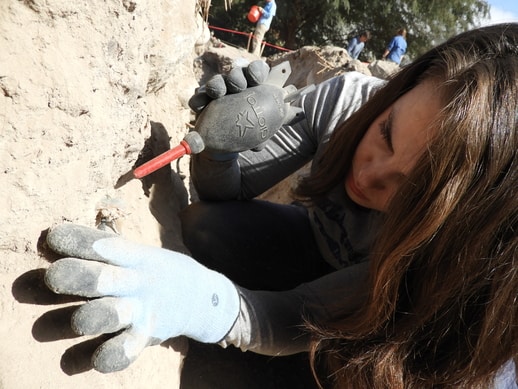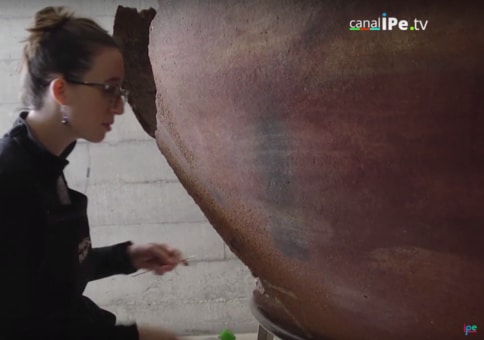International Archaeology Day (IAD), which is organized through the Archaeological Institute of America (AIA), is celebrated every year on the third Saturday of October. This year it falls on October 20th, today! In recognition of archaeology and in collaboration with the Archaeological Discussion Group (ADG), the Emerging Conservation Professionals Network (ECPN), and the UCLA/Getty Program for Conservation of Archaeological and Ethnographic Materials, the current UCLA/Getty conservation students share their summer experiences. We hope that this post encourages interest and support in the field of archaeological conservation and illustrates the range of knowledge in a diversity of fields required for conservation. These experiences also show the ways in which conservators can provide a better understanding of an object’s contexts and technologies and preserve them for the future.
Each summer between their first and second years, UCLA/Getty conservation students attend ten weeklong internships. Many of these students work on excavations or with archaeological materials from sites around the world. Here are their stories:
Austin Anderson:
 Austin consolidates flaky paint on a Congolese mask at RMCA
Austin consolidates flaky paint on a Congolese mask at RMCA
Summer has flown by! For the first five weeks of his summer, Austin was working at the Yosemite Museum at Yosemite National Park in California. While there, he worked on rehousing their cradle baskets and beaded jewelry collections. Due to limited space availability, the cradle baskets required special padded storage mounts so that they could be safely stacked on top of each other. Unfortunately, his internship was cut short due to evacuations caused by the Ferguson fire. While away from the museum Austin performed research into areas beneficial for the museum, such as looking into visible storage solutions and soot remediation should it be needed due to the fires. For the second half of his Austin was in Belgium for five weeks working at the Royal Museum for Central Africa (RMCA) located outside of Brussels. He was very excited to be working under the supervision of Siska Genbrugge, an alumna of the UCLA/Getty conservation program! While here, he helped to complete various treatments for objects that were going back out on display, as well as assisted with object re-installation, as the museum prepares to completely reopen after five years of renovation.
Elena Bowen (@Elena Bowen)
 at Corral Redondo, Elena excavated delicate feather textile fragments.
at Corral Redondo, Elena excavated delicate feather textile fragments.
This summer, Elena worked for six weeks at the Fowler Museum at UCLA in Los Angeles and four weeks at the Institute for Field Research (IFR) Corral Redondo Project in Iquipi, Peru. At the Fowler Museum, Elena worked on treating and documenting new acquisitions, which ranged from native California to Australian aboriginal bark paintings, to Mexican polychrome . In addition to these treatments, Elena began her thesis research on coconut shell by conducting a condition survey of all coconut shell objects in the Fowler collection. During the first season of the Corral Redondo project, she helped to set up a conservation lab in the local school’s museum where the conservation team treated and improved the display conditions for archaeological textiles. In the lab, Elena also helped to supervise field school students during their conservation block rotations. , she worked with field school students to reconstruct a monolith and excavated delicate feather textile fragments from the main trench. In addition to conservation work, Elena engaged with the local community participating as a judge in the school science fair, teaching ceramic reconstruction to students and faculty at an open house, and learning about the rich local culture from community members.
Kasey Hamilton (@Kasey Hamilton)
 Kasey applies bulked ethyl silicate consolidant behind a lifting surface layer
Kasey applies bulked ethyl silicate consolidant behind a lifting surface layer
on a sandstone stele at the National Museum of Cambodia.
Kasey Hamilton spent her summer working with French and Cambodian conservators at the Sculpture Conservation Workshop at the National Museum of Cambodia/EFEO in Phnom Penh. During her internship, she surveyed the collection to record evidence of polychromy remains on stone sculptures and architectural elements, compiled existing information on the identification of pigments and lacquers present, and identified areas for further study. She also worked on stone consolidation treatments and assisted with structural repairs of monumental sandstone sculptures. During her time in Cambodia, Kasey had the opportunity to travel to the pre-Angkorian site of Phnom Da as well as several Angkorian temples in and around Siem Reap. These visits helped to further understand the original context of many of the stone objects and artifacts in the collections of the National Museum, as well as conservation efforts at these various cultural heritage sites.
Skyler Jenkins
 Skyler cleans and coats iron finds at the
Skyler cleans and coats iron finds at the
Villa Romana di Poggio Gramignano site in Italy
This summer Skyler had the opportunity to work in three locations: Italy, Turkey, and Cyprus. In Italy, Skyler was continuing work as a site conservator on a project she has been associated with since 2016 at the site of Villa Romana di Poggio Gramignano in Umbria. This year she was able to begin a condition survey of material excavated thirty years ago. Skyler was also able to squeeze in -four object treatments. In Turkey, she had the opportunity to work under conservator Julie Unruh at the site of Tell-Tayinat. Within two weeks, she was able to work on glass, monumental basalt sculpture, part of an iron shield, create and update microclimates for metal storage, undertake a preliminary study of fills for the basalt sculpture with a fellow intern, and assist the registrar and lab manager with photography of small finds. In Cyprus, she collaborated with UCLA Ph.D. colleague Roxanne Radpour from the Materials Science and Engineering department on her dissertation work to help identify pigments of Hellenistic wall paintings non-invasively. Skyler provided a conservation approach to the wall paintings by assessing the condition of each and ensuring that no damage would occur, while helping to optimize certain aspects of Roxanne’s investigation.
Emily Rezes:
 Emily cleans old fill material out of a large ceramic
Emily cleans old fill material out of a large ceramic
using alcohol and cotton swabs
This past summer Emily had the wonderful work with the amazing staff at the Pachacamac Site Museum in Lima, Peru. The collections held at the museum are expansive, and Emily and her supervisor, Angelica Isa Adaniya, worked on ceramic, metal, stone, shell, metal, wood, leather and paper objects as well as human and animal remains - all in the ten short weeks that she was in the lab! Part of their work also involved public outreach. Our treatment of a large ceramic from the Ychma period took place over six weeks and all of the work was completed in the gallery space due to the size of the object. While working, Emily and her colleagues were able to answer questions about their treatment, the history and use of the , and the museum at large. They also had the opportunity to share our work and represent the role of conservation in the museum to a national audience. Her supervisor was interviewed by an excited and inquisitive team from Canal IPe, a public television network, and their discussion highlighted the museum’s outreach program with local school children as well as the day-to-day work that a conservator completes. In the image above you can see a capture of her cameo during the interview as Emily worked on cleaning old fills on the in the gallery space! To see the interview in full, click here!
Megan Salas:
 Megan reconstructs a Roman ceramic vessel excavated near Petalidi.
Megan reconstructs a Roman ceramic vessel excavated near Petalidi.
This material belongs to the Ephorate of Antiquities of Messinia,
it is unpublished and the reproduction of the photos is prohibited.
Megan spent eight weeks working in the conservation lab of the Archaeological Museum of Messenia in Kalamata, Greece. She worked on several objects recently unearthed in an ongoing excavation near the village of Petalidi, Greece. She treated two ceramic objects--an amphora and a loom weight--as well as a fragment of a marble tombstone; the objects are from the Hellenistic and Roman periods. Megan was also able to gain experience at the Laboratory of Archaeometry of the Department of History, Archaeology and Cultural Resources Management at the University of the Peloponnese. She used XRF and SEM/EDS to analyze several items--including an iron set of athlete’s tools--from the New Pylos Archaeological Museum in order to learn more about their compositions and production technologies.
The UCLA/Getty program accepts students every other year and is accepting students for a Fall 2019 start. They have also just created a conservation Ph.D. program and are accepting students for Fall 2019.
If you are interested in learning more about archaeological conservation, AIA, IAD, ADG, ECPN, or the UCLA/Getty Program, below are some useful links:
Archaeological Conservation
AIA
International Archaeology Day
ADG
ECPN
UCLA/Getty Conservation Program
#archaeologicalconservation #UCLAgetty #internationalarchaeologyday #EmergingConservationProfessionalsNetwork
#Featured